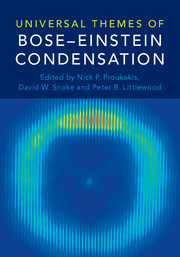Book contents
- Frontmatter
- Contents
- Foreword
- Preface
- Part I Introduction
- Part II General Topics
- Part III Condensates in Atomic Physics
- Part IV Condensates in Condensed Matter Physics
- Editorial Notes
- 19 Bose-Einstein Condensation of Photons and Grand-Canonical Condensate Fluctuations
- 20 Laser Operation and Bose-Einstein Condensation: Analogies and Differences
- 21 Vortices in Resonant Polariton Condensates in Semiconductor Microcavities
- 22 Optical Control of Polariton Condensates
- 23 Disorder, Synchronization, and Phase-locking in Nonequilibrium Bose-Einstein Condensates
- 24 Collective Topological Excitations in 1D Polariton Quantum Fluids
- 25 Microscopic Theory of Bose-Einstein Condensation of Magnons at Room Temperature
- 26 Spintronics and Magnon Bose-Einstein Condensation
- 27 Spin-Superfluidity and Spin-Current Mediated Nonlocal Transport
- 28 Bose-Einstein Condensation in Quantum Magnets
- Part V Condensates in Astrophysics and Cosmology
- Universal Bose-Einstein Condensation Workshop
- Contributors
- Index
- References
25 - Microscopic Theory of Bose-Einstein Condensation of Magnons at Room Temperature
from Part IV - Condensates in Condensed Matter Physics
Published online by Cambridge University Press: 18 May 2017
- Frontmatter
- Contents
- Foreword
- Preface
- Part I Introduction
- Part II General Topics
- Part III Condensates in Atomic Physics
- Part IV Condensates in Condensed Matter Physics
- Editorial Notes
- 19 Bose-Einstein Condensation of Photons and Grand-Canonical Condensate Fluctuations
- 20 Laser Operation and Bose-Einstein Condensation: Analogies and Differences
- 21 Vortices in Resonant Polariton Condensates in Semiconductor Microcavities
- 22 Optical Control of Polariton Condensates
- 23 Disorder, Synchronization, and Phase-locking in Nonequilibrium Bose-Einstein Condensates
- 24 Collective Topological Excitations in 1D Polariton Quantum Fluids
- 25 Microscopic Theory of Bose-Einstein Condensation of Magnons at Room Temperature
- 26 Spintronics and Magnon Bose-Einstein Condensation
- 27 Spin-Superfluidity and Spin-Current Mediated Nonlocal Transport
- 28 Bose-Einstein Condensation in Quantum Magnets
- Part V Condensates in Astrophysics and Cosmology
- Universal Bose-Einstein Condensation Workshop
- Contributors
- Index
- References
Summary
A quantised spin wave – magnon – in magnetic films can undergo Bose-Einstein condensation (BEC) into two energetically degenerate lowest-energy quantum states with nonzero wave vectors ±kBEC. This corresponds to two interfering condensates forming spontaneously in momentum space. Brillouin Light Scattering studies for a microwavepumped film with submicrometer spatial resolution experimentally confirm the existence of the two wavefunctions and show that their interference results in a nonuniform ground state of the condensate with the density oscillating in space. Moreover, fork dislocations in the density fringes provide direct experimental evidence for the formation of pinned half-quantum vortices in the magnon condensate. The measured amplitude of the density oscillation implies the formation of a nonsymmetric state that corresponds to nonequal occupation of two energy minima. We discuss the experimental findings and consider the theory of magnon condensates, which includes, to leading order, the contribution from the noncondensed magnons. The effect of the noncondensed magnon cloud is to increase the contrast of the asymmetric state and to bring about the experimental measurements.
Introduction
Magnons are quasiparticles corresponding to quantised spin waves that describe the collective motion of spins [1]. In recent years, it has become possible to realise a BEC of magnons in two remarkably different systems: in superfluid phases of an isotope of helium – Helium-3 at ultralow temperatures [2, 3] and in ferrimagnetic insulators [4, 5, 6, 7]. In the normal, noncondensed state, these magnetic materials exhibit a magnetically ordered state with a gas of magnons whose phases are not correlated. However, once condensation occurs, spins develop phase coherence resulting in a common global frequency and phase of precession. At room temperature, ferrimagnetic insulators, such as yttrium-iron garnet (YIG) films, together with a combination of an in-plane magnetic field and microwave radiation, are required for the magnon condensation [4, 5, 6, 7]. Therefore, in analogy with exciton– polariton condensates, this provides yet another example of a BEC of quasiparticle excitations in a solid-state system.
Experimental Realisation of a Bose-Einstein Condensateof Magnons in an Epitaxial YIG-film
A room-temperature Bose-Einstein condensate of magnons was created in an epitaxial YIG-film using an experimental setup shown in Fig. 25.1a, which, in general, is similar to that used in our previous studies [4, 5]. Given that magnons are quasiparticle excitations, their number is not conserved and, therefore, the chemical potential is zero.
- Type
- Chapter
- Information
- Universal Themes of Bose-Einstein Condensation , pp. 493 - 504Publisher: Cambridge University PressPrint publication year: 2017

